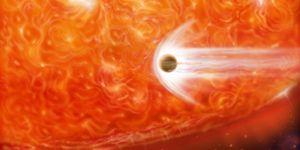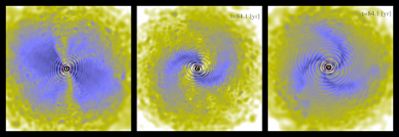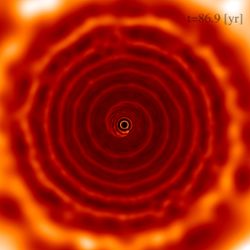In the wake of a dying sun
Poets have described the sun through the ages and so perhaps did Dylan Thomas when he wrote: “Do not go gently into that good night.”

In a few billion years, our star will start to die in a decidedly ungentle series of events. It will become what’s known as a red giant, growing to hundreds of times its current size and engulfing Mercury, Venus and possibly Earth in the process. “Old age should burn and rave at close of day” indeed.
It’s no secret that this is what time has in store for our sun, but astronomers still have questions about how this fate will reshape the surviving solar system. Now, with unprecedented computer simulations, a Michigan State University researcher has vividly painted some of the possibilities.
“There are a lot of artistic representations of what the solar system might look like, but what we’ve done includes actual physics and calculations,” said Elias Aydi, a research associate in the College of Natural Science’s Department of Physics and Astronomy. “This is the first time we’ve had this type of simulation done in 3-D to predict the end result of stars with nearby companions, similar to our future solar system.”
The work was accepted on March 12 for publication and published on March 29 in the peer-reviewed journal Monthly Notices of the Royal Astronomical Society.
Aydi is the first author of the study, which was a collaboration with Shazrene Mohamed, an associate professor at the University of Miami and an astrophysicist with the South African Astronomical Observatory, or SAAO.

The duo found that interactions between a red giant star and a nearby substellar object will create distinct structured patterns, such as arcs and multiarmed spirals, in the environment around the star.
In our solar system, the sun will have grown so much that the nearby substellar object would be Jupiter. In other solar systems, that neighbor could be an even larger planet or what’s known as a brown dwarf, a celestial object that’s larger than a gas giant planet but smaller than a star.
Time will tell if arcs and spirals appear in our solar system, but astronomers can start looking for them now near other sun-like stars in the Milky Way.
“We have new cutting-edge technology and cutting-edge facilities that should be able to resolve these types of structures elsewhere in our galaxy,” Aydi said. That cutting-edge group includes the recently launched James Webb Space Telescope and the Atacama Large Millimeter/submillimeter Array, or ALMA, Observatory in Chile.
“Although astronomers have found and studied single spirals in systems where there's a red giant and another star, multiple spirals from a red giant and a substellar companion have never been observed before,” Aydi said. “Finding them would confirm the outcome of these simulations and show what our solar system may one day look like.”
What exactly that picture looks like is tied to several features of the interactions between the red giant star and its nearby large companion planet or brown dwarf.
As a star expands into a red giant, it spreads gas and dust across its solar system as if filling up a swimming pool. The star also pulsates, growing and shrinking in cycles, which sends shockwaves that ripple through the pool of gas and dust. The star’s nearby companion continues to circle through the churning pool.
“The shockwaves interact with the wake of the nearby companion,” said Mohamed, who was Aydi’s doctoral thesis adviser at SAAO and the University of Cape Town in South Africa. “It is similar to when ocean waves meet the wake of a speedboat.”
Elias Aydi and Shazrene Mohamed created a video of their computer simulations showing celestial interactions that could be a preview of the fate of the solar system.
It’s how the waves and wake line up that determines the shape of the pattern in the gas. Physically, this translates to how the orbit of the companion syncs up with the star’s shockwave cycle.
For example, if the planet circles the star once in exactly the time it takes the star to pulsate twice, two bar-like structures grow through the gas and dust cloud. But if that ratio isn’t exactly 2-to-1, the bars start to curve and create a two-armed spiral instead. If the ratio is closer to 3-to-1 — again, without being exact — the spiral gets a third arm.

“I think it’s unlikely that we end up with bars, though,” Aydi said. “The spirals are much more interesting and much more fun to look at.”
Aydi and Mohamed used a numerical method known as smoothed particle hydrodynamics for their simulations, which has a proven track record in science, engineering and even entertainment. Computer animators working on Peter Jackson’s “The Lord of the Rings” movies used the method to simulate the lava of the fictional Mount Doom, Aydi said.
The technique was also a good fit for simulating a red giant with a nearby companion, but performing the simulations still required loads of patience, persistence and computational power.
“One of the reasons this hasn’t been done before is the complexity of the physics and the calculations. We needed clusters or supercomputers, which are multiple computers working at the same time on the same calculation,” Aydi said. “If we wanted to run these simulations on a normal, commercial laptop or desktop, it would take years.”
Instead, the simulations could run on a timescale of weeks. But Aydi and Mohamed still needed to run a range of scenarios, exploring the different variables that affect the picture of the simulated system.

“These simulations are massive,” Aydi said. “We’re talking hundreds of terabytes of data.”
He had started this project as a grad student before joining MSU in 2018.
“The long computational time needed to produce these simulations and two unfortunate storage tragedies caused by the massive size of the simulations delayed the project significantly, to a point where we almost abandoned it,” he said. “But about a year and half after I got to MSU, we decided it would be a shame not to publish the work.”
He and Mohamed got back to work and pushed the project over the finish line.
“I am extremely happy that this project actually saw the light of day,” Aydi said.
Banner image: Spartan astronomer Elias Aydi is helping show what our solar system and others may look like when they enter their final acts. As shown in the above illustration, if the companion (a bright spot on the first bright ring outside the star) ends up far enough from the star, a spiral with a single arm would be seen. Credit: Courtesy of Elias Aydi